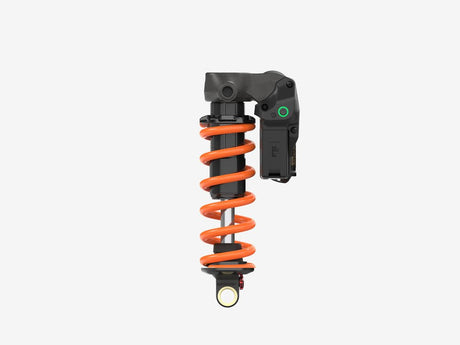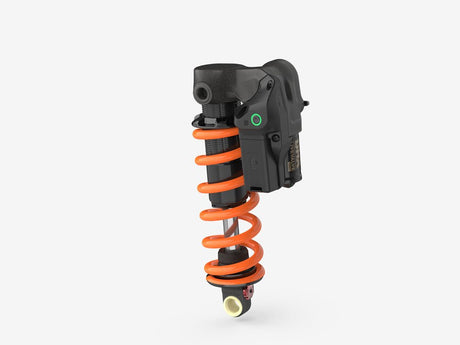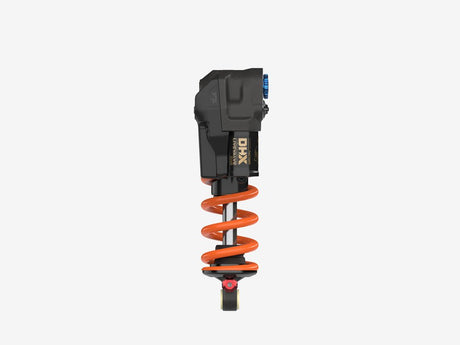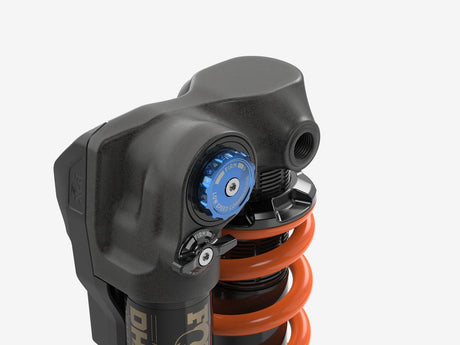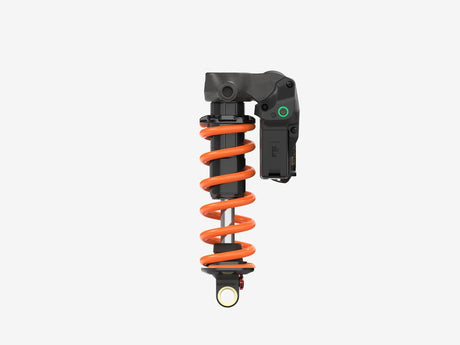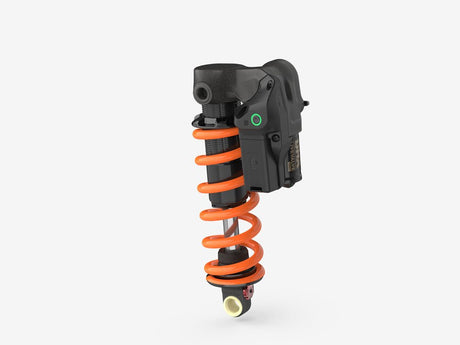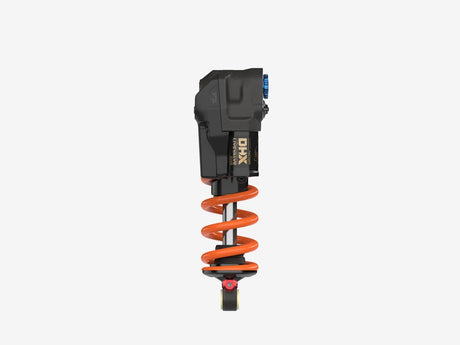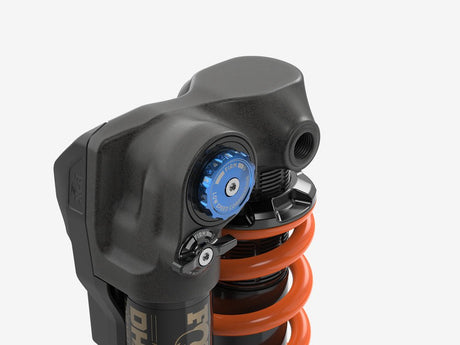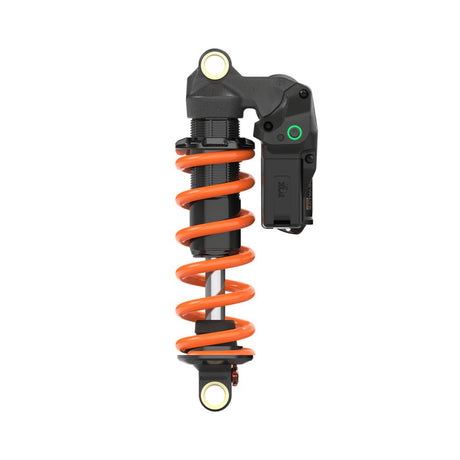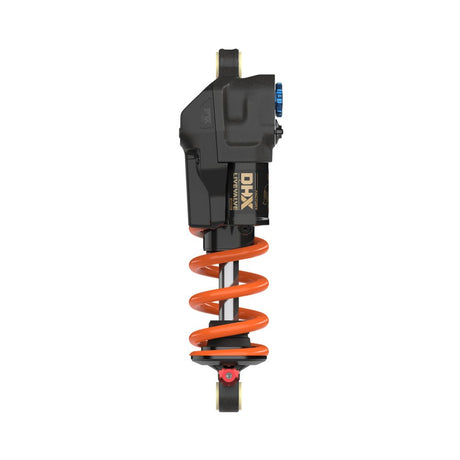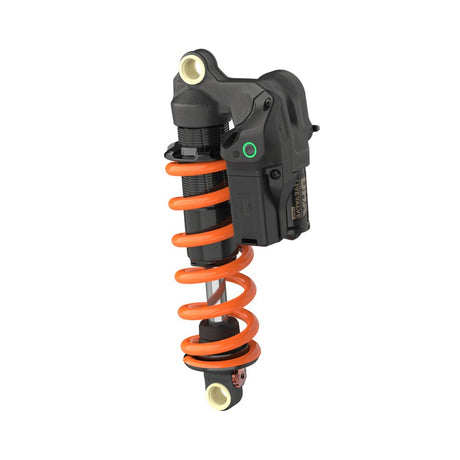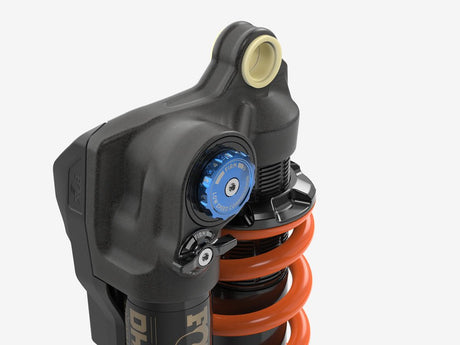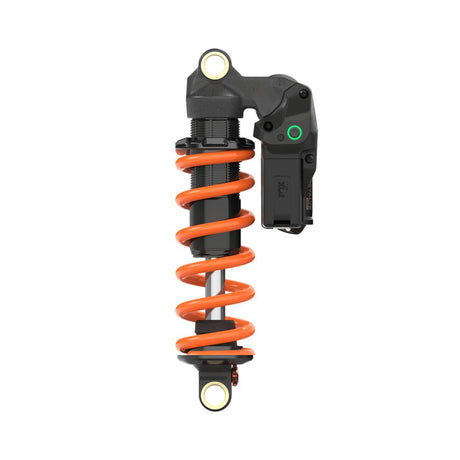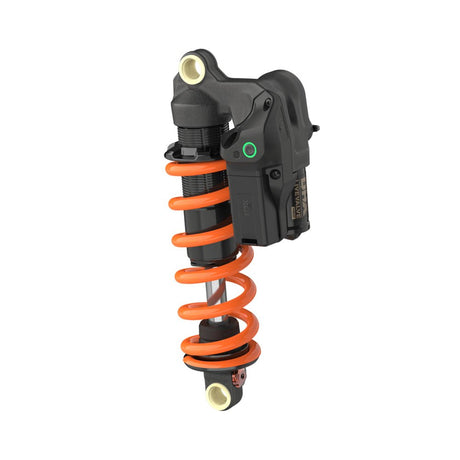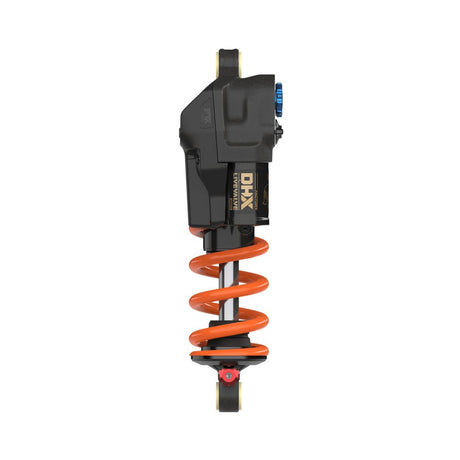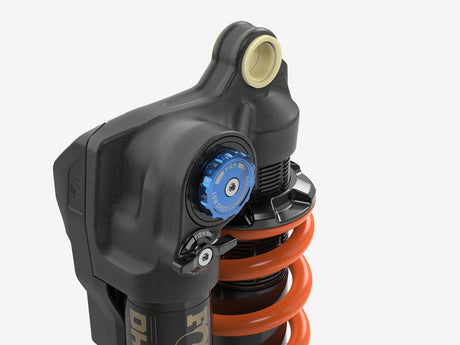Intro
Fox is entering the wireless electronic suspension game with their Live Valve Neo rear shocks, something we’ve seen teased on pro rider’s bikes for a couple years now. Well it’s here for the masses now, with a level of refinement that takes years to perfect and perfect it they did. Live Valve Neo is available on Fox’s Float X and DHX shocks, and they use sensors attached to your brake calipers to open and close compression circuits almost instantaneously to improve pedaling efficiency without compromising downhill performance. Bringing the whole package together is Fox’s Neo app, which we’ve already seen used with the wireless Transfer Neo dropper post, and it offers an almost overwhelming amount of adjustability to customize how your Live Valve suspension behaves in different terrains. I’ve been living with a Fox Live Valve DHX on my Chromag Lowdown for the last couple months, playing with as many different settings as possible and learning the ins and outs of the system, and I’ll give my complete review towards the end of this article.
Fox Float X Live Valve Neo
- 669g (185x55mm shock, sensors, battery)
- 125 hour service interval
- 15-20 hour battery life
- Factory and Performance Elite Series (PE is OEM only)
- 11 tool free clicks of Open Low Speed Compression
- 6 tool free clicks of Firm Compression
- 9 tool free clicks of Rebound
- Trunnion eyelet: 165x45mm, 185x55mm, 205x65mm, 225x75mm
- Standard eyelet: 190x45mm, 210x55mm, 230x65mm, 250x75mm
- Can be travel reduced by 2.5mm increments up to 7.5mm
- $999
- Must buy Live Valve Neo Kit separately
Fox DHX Live Valve Neo
- 701g (185x55mm, sensors, battery, no spring)
- 125 hour service interval
- 15-20 hour battery life
- Factory Series only
- 11 tool free clicks of Low Speed Compression
- 6 tool free clicks of Firm Compression
- 9 tool free clicks of Rebound
- Trunnion eyelet: 185x55mm, 205x65mm, 225x75mm
- Standard eyelet: 210x55mm, 230x65mm, 250x75mm
- Can be travel reduced by 2.5mm increments up to 7.5mm
- $949 (Spring sold separately)
- Must buy Live Valve Neo Kit separately
Available in Float X and DHX flavors
Tech
Live Valve isn’t a new term, and Fox released the first version of their Live Valve suspension back in 2018, with wires running from batteries to sensors to forks and shocks, but us mountain bikers are a picky bunch, and all those wires didn’t tickle our collective fancy. That first generation struggled to catch on, with only a few frame manufacturers offering Live Valve equipped complete builds, and speccing the system aftermarket had a prohibitive number of hoops to jump through to say the least. At the time, wireless technology just wasn’t fast enough to unlock a shock when you hit a bump, so wires were the answer. Now, things have changed, and the Neo wireless technology is lightning quick, opening and closing the compression circuit in less than 15 milliseconds. In comparison, Bluetooth latency is about 200 milliseconds, and the speed at which it activates is fast enough for it to feel completely natural on trail. RockShox hasn’t published any numbers on the latency of their Flight Attendant system, but Fox tells us Live Valve Neo is faster in a race from hitting a bump to unlocking the shock. Fox uses a paired down version of Bluetooth for the sensors and shock to communicate, and has stripped away all of the cumbersome features of Bluetooth that makes it ultra compatible with all hardware to speed things up for this very specialized purpose.
Made up of four parts, Live Valve uses the shock itself, a sensor on the front wheel, a sensor on the rear wheel, and the Fox Bike app on your phone. Things move pretty fast on a mountain bike, and the two sensors are taking inputs 400 times per second to tell the shock exactly what’s happening on the trail. Using a built in accelerometer, the sensor at the front wheel measures the angle of the trail, and any bumps you’re hitting with the front wheel. On the other end of the bike, the rear sensor is just measuring the bumps experienced by the rear wheel, and while both sensors are attached to your brake calipers, they do not take any information about your braking. They’re mounted to the brake caliper bolts to get as close to your axle as possible, and they’re strictly concerned with the angle of the trail and the bumps that you’re hitting. Attached to the shock is the controller, which opens or firms up the shock’s compression circuit based on the data sent to it by the sensors using a 2-position magnetic latching solenoid. That controller is powered by a rechargeable battery, the same one used in the Transfer Neo dropper post, but not the same one used in SRAM’s AXS systems. Lastly, the Fox Bike app is used to set up the system, monitor battery levels, update the system, report diagnostics, and ‘tune’ your shock. More on that later.
There is a fifth component, the Handlebar Switch, that was initially meant to release simultaneously with the rest of the components covered here, but it’s still in development and will most likely be released some time in 2025. You’ll notice an empty slot in the box during your unboxing experience, and no, yours isn’t missing something that everyone else got. Unfortunately, we’re all without the Handlebar Switch for now. One day in the not too distant future, when we do have this piece, we’ll be able to switch between our custom ‘tunes’ on the fly, changing the nature of the shock with just the flick of a switch. To get all of the components besides the shock, you'll need to purchase the Live Valve Neo Kit, which contains the Front and Rear Bump Sensors, Battery, Charger, Charger Cable, and eventually Handlebar Switch.
While you’re riding, the Live Valve Neo shock will switch between its Open and Firm modes, departing from the classic three positions that Fox has used in the past. Their reasoning is that in a three position system, the middle mode was a compromise between Open and Firm, and being somewhere between them was better than committing to one of them when you couldn't switch back and forth instantly. But now, the Live Valve Neo system doesn’t need to compromise between the two, and it can continuously determine which mode is better for you at any given moment, leading to increased efficiency across the board. Your Open and Firm modes have independent controls and compression circuits, with the familiarly colored blue dial acting as your compression control for the Open mode, while the black dial just next to it controls how firm the Firm mode is.
App
Downloading an app for a mountain bike shock is new to me, but I’m open to new experiences. Overall, the Fox app has tons of thoughtful features, isn’t cumbersome, and feels like it was built by mountain bikers. The feature I’m most excited for, as boring as it sounds, is tracking the hours on the suspension for service purposes. Just about everyone that walks into our service department at The Lost Co has no clue how many hours their suspension has, and it’s impossible to blame them. No one really knows, and everyone is kind of guessing about whether or not they've hit their service intervals. Now you know exactly when it’s time to take your bike into the shop, and you can even schedule a service from inside the app. Something important to note, you can leave your phone at home when you go for a ride, and the system doesn’t need it nearby to work. But the main reason to download the app is to ‘tune’ your new Neo shock.
Shock 'Tunes'
Custom shock tunes have been the talk of the town recently, with custom valving in the compression and rebound circuits becoming normalized with RockShox offering bike specific tunes for just about all of their shocks. I’m using quotes around the 'tunes' Fox’s Live Valve system implements because it’s not changing the actual valving of the shock, it’s tuning what kind of conditions cause the shock to switch between Open and Firm modes. This tuning happens inside the accompanying app, and there is an eye watering number of adjustments you can make to the system once you switch it into Precision Mode. With separation between the front and rear sensors, G thresholds, angle at which climb mode engages, coupling or decoupling the sensors, control over how long the shock is open, and more, it sounds overwhelming, and it definitely can be, but Fox explains exactly how every single adjustment changes how your shock works. For the tinkerers, this is an absolute dream, with all the rabbit holes you could dream of to dive into and obsess over.
Each tune is made up of a Climb, Flat, and Descend state. Your shock is always in one of those states depending on the angle your bike is pointed, and you can decide at which angle your tune switches between the three. In each state, you can adjust the criteria for the shock switching between Open and Firm with a few different options we mentioned earlier. First is the bump sensitivity threshold, and you can control exactly how big of a bump it’s going to take to open up the suspension. It’s measured in G’s, and is split between the front and rear sensors to control how the bike reacts to different impacts. Next is how long the suspension stays open when it encounters a bump before going back to the Firm mode. The system defaults to closed, so if it’s not hitting any bumps for the length of time specified in the app then it’ll go into Firm mode until it encounters one of those bumps that satisfies the bump sensitivity threshold. You can also completely disregard any bumps hit by the front wheel by ‘decoupling’ the system, so only bumps from the rear wheel are going to influence the shock. Lastly, you can override all of those adjustments I mentioned, and lock the shock in Open or Firm. That way if you want the shock to always be in the Firm mode on a climb or always Open on the descent, you can make that so.
Your Neo shock will come preloaded with a few tunes, and I recommend starting with one of those and then tinkering with it to your liking. Or if you just want to take advantage of someone else’s hard work, you can download a tune that someone else has developed, and I’ve got a few extra tunes loaded on my app. The Shore Tune was developed by someone riding the North Shore trails in Vancouver, and the TransBC tune was created by Nick McLeod, who used it to win the 2024 TransBC race. Sharing tunes is super straightforward. Just scan a QR code or share a link, and given how different riding conditions are in different areas, I can see it being popular to download a tune developed specifically for a region to get the most out of your fancy robotic shock.
Each 'Tune' contains a Climb, Flat, and Descend mode, with each mode offering all of these adjustments
Setup
During a Fox event at Crankworx Whistler this year, we were walked through all of this new tech, but I asked to set it up myself to get the same experience as anyone else walking through the app for the first time. With an engineer that helped design that system looking over my shoulder, the Live Valve Neo system was almost entirely painless to install. The app made everything very clear, and pairing all the sensors to the shock was no big deal, besides the fact that 20 people were all trying to pair at once and no one could get the right sensors to pair to their shock. Luckily you won’t have that issue, and the only issue I ran into that you might encounter was with calibrating the sensors. Calibrating requires setting the bike on a level surface and letting the sensors align their chakras or something like that, but my incredibly large Hope Tech 4 V4 brakes were getting in the way of the sensors getting proper alignment. Quickly swapping to the lower brake bolt fixed this issue, and Fox said this was the only brake they’d seen with this issue. Overall, I would expect anyone comfortable using a smartphone to easily set up this system.
That bleed port got in the way of the Fork Sensor living on the preferred top bolt, but the bottom bolt functions the same.
Setting up spring rate, compression, and rebound on this shock was identical to every other coil shock I’ve installed, and this was my first time on Fox’s DHX platform. When this very expensive Live Valve DHX is open, this shock performs identically to a much less expensive analog DHX, so all of the external adjustments on this shock are very familiar if you’ve set up any shock in the last 10 years. The only difference is the firm mode adjust lever, which sits right below the LSC knob, and adjusts how firm your pedal platform is when the shock goes into Firm mode. Each click made a relatively small difference in how firm the Firm mode was, except for the last click, which really shut things down and got close to a true lock out. I ended up with all but that final click of firmness on the new dial, and I suspect lots of folks will find the same works for them. Finding the rest of the clicks was relatively painless, and I ran my rebound about in the middle and the compression mostly closed.
Riding
Our first day on the new Live Valve was on a classic Whistler loop, Comfortably Numb to Out There, full of techy punchy climbs on the way up to a slab filled descent with plenty of rough sections and punchy pedally bits in between. It’s almost like Fox curated the perfect trail to show off their fancy new shocks… Tin foil hat aside, Live Valve Neo really does work, and disappears into the background while riding. With amazingly quick changes between Open and Firm modes and no audible buzz from the magnetic solenoid while performing its song and dance, Live Valve Neo feels like the natural progression of suspension, requiring zero thought while riding and giving you a bump in efficiency along the way. A little green light by the battery is the only external indication that the shock is working, and comes on whenever the shock goes into Open mode. On the first couple rides I had a hard time looking where I was going and was sneaking peeks down at the shock at every opportunity to figure out exactly what set it off, especially after making tweaks to my tune in the app.
This was my first experience with a Fox coil shock, and the DHX platform seriously impressed me after having spent lots of time on the Vivid Coil this summer. While descending on the Live Valve equipped DHX, it’s almost always in the Open mode, and this is just a damn good coil shock. Inevitably there will be folks wishing that the Live Valve tech was offered on the more adjustable DHX2, and that’s a fair criticism given the high price of the Live Valve System, but the DHX offered all the performance I could ask for. Access to a High Speed Compression adjustment would have been nice, as I feel the shock was a bit light in that department. Ppotentially a true custom tune could be in order down the line. Overall, the DHX had the suppleness you’d expect from a coil shock in its early stroke, with a supportive mid stroke that is controlled very nicely with the Low Speed Compression circuit. I ran quite a bit of LSC to get the mid stroke support I wanted, and ended up just a couple clicks from closed to stay up in the travel.
Robotic suspension is new to me, and I would consider myself both excited at the prospect of true innovation in mountain bike suspension while also hesitant to make things more complicated and need to charge yet another battery. Not long ago I pulled an X0 Transmission off my bike and replaced it with a GX 11 speed drivetrain that was released in the previous decade, so it’s clear I’m a fan of keeping it simple. But I’m open to the latest and greatest, especially when it comes to suspension, and Fox Live Valve is exactly that. The efficiency of the system is undeniable, and when grinding up a long climb, tampering that pedal bob is a welcome change, and a firmer platform when stomping on the pedals through traversing sections of trail does make me feel like an enduro racer. Like I mentioned earlier, I wanted the pedal platform to feel firm and efficient, but not locked out, and using all but one click of the Firm mode adjust lever gave me exactly that.
You'd be forgiven if you mistook this shock for a regular DHX
After playing with tons of different tunes in the shock, I gravitated towards a setup that was generally resistant to opening, and would close again relatively quickly. With the option to close up the shock, taking advantage of it as often as possible seemed like the natural choice, and I imagine most folks buying this system are doing so in pursuit of pedaling efficiency, and leaving it open doesn’t really accomplish that. So by increasing the Bump Threshold and decreasing the Open Timer in the Fox Bike app, I was able to accomplish exactly that, giving me a more firm rear end more often. Interestingly, I learned a bit about what kinds of impacts my wheels are taking and what those numbers feel like when they hit my hands and feet. With the Bump Threshold low, around 3-4gs and less, my shock would open whenever I put a good pedal stroke in, and seemed to defeat the whole purpose of firming up for efficient pedaling. The stock Firm tune was very close to what I ended up preferring, and I went even firmer with the Bump Threshold, getting into the double digits for Climb and Flat modes. That way I was able to really pedal the bike without the shock opening up and wallowing on me, giving me that efficiency I think everyone is after with this shock.
Decoupling the sensors was another thing I played with, which essentially lets the shock ignore any information from the front sensor and listen solely to the rear sensor. This allowed me to pick up the front wheel over anything in the trail and retain that pedal platform for a last little kick to hop up and over a technical climb, and was overall an improvement in climbing performance. Riders going through incredibly technical climbs could benefit from having impacts at the fork open up the shock for increased traction, and I left the shock Coupled in the flat mode while Decoupled in the Climb mode.
In Descend mode, I ran the shock far more open, looking for a more normal coil experience when I’m really pushing it and looking for all the traction I can get. I didn’t run the shock locked in the Open mode, but ran the Bump Threshold much lower and increased the open timer to a couple seconds. Even little pebbles would keep the shock open and there was really never a time that the shock was in the Firm mode in the descents, which is exactly what I wanted.
Lastly, something that Fox mentions several times is that the shock defaults to Firm mode in all scenarios. I think this is poorly worded and made me uneasy at first, because I thought that would mean the system would be locked in Firm mode if the battery died. Luckily that’s not the case, and if the battery dies, the shock is left Open and functions as a vanilla DHX, albeit with a heavy controller attached to it. Fox says that it defaults to Firm mode because that’s what it does while the battery is charged, and will only go into Open mode when prompted by one of the sensors, but I found that to be a bit confusing.
Everyone's gotta be different. Unfortunately not a match with AXS batteries
Is this the shock for you?
With this being Fox’s first foray into the electric suspension game, no one expected it to be cheap, and coming in at ~$1400 for the kit, it’s about as spendy as you can get with a rear shock. Somehow that’s still less than Push’s ElevenSix shock, but that doesn’t mean it’s cheap. That price tag means it’s clearly not for everyone, and I think this technology is almost exclusively made for the die hard enduro racer. For those of you spending your weekends between the tape and chasing those marginal gains, doubling your rear shock budget could be a swallowable pill, and you’d be willing to deal with charging a battery if it means a leg up on the competitors. But for the majority of people, I can’t say that this shock is going to transform your riding experience, especially with how efficient the vast majority of rear suspension designs are these days.
If unending tinkering is your cup of tea, then the Fox Bike app is pretty amazing and offers without a doubt the most tinkering opportunity of any mountain bike component out there right now, and you could spend a lifetime trying every combination of Bump Threshold and Open Timers. But if you’re a set and forget rider that isn’t concerned with eeking every ounce of perfection out of your suspension, then you don’t need me to tell you that spending your hard earned dollars elsewhere on your bike could be a better investment. I really enjoyed my time with the Live Valve Neo suspension, and if I was still racing enduro and didn’t mind an extra battery strapped to my shock, then I would be all in with the new Neo Technology.
Conclusion
Fox has taken their time to develop and release their Neo suspension, and they’ve released a refined product that increases any rider’s efficiency across the board. Live Valve Neo is the natural progression of their Live Valve platform, cleaning up the cables and giving it a modern look, and modern performance that goes toe to toe with RockShox’s Flight Attendant system. If you’re looking for the latest and greatest in suspension technology, look no further than the Fox Live Valve Neo rear shocks.

